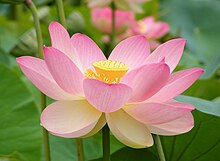Regarded as the "queen of Indian flowers", the Lotus is the national flower of India and is considered sacred by Hindus and Buddhists.
India, which lies within the Indomalaya ecozone, displays significant biodiversity. One of eighteen megadiverse countries, it is home to 7.6% of all mammalian, 12.6% of all avian, 6.2% of all reptilian, 4.4% of all amphibian, 11.7% of all fish, and 6.0% of all flowering plant species.Many ecoregions, such as the shola forests, exhibit extremely high rates of endemism; overall, 33% of Indian plant species are endemic.
India's forest cover ranges from the tropical rainforest of the Andaman Islands, Western Ghats, and northeastern India to the coniferous forest of the Himalaya. Between these extremes lie the sal-dominated moist deciduous forest of eastern India; the teak-dominated dry deciduous forest of central and southern India; and the babul-dominated thorn forest of the central Deccan and western Gangetic plain. Important Indian trees include the medicinal neem, widely used in rural Indian herbal remedies. The pipal fig tree, shown on the seals of Mohenjo-daro, shaded Gautama Buddha as he sought enlightenment. According to latest report, less than 12% of India's landmass is covered by dense forests.
Many Indian species are descendants of taxa originating in Gondwana, from which the Indian plate separated. Peninsular India's subsequent movement towards, and collision with, the Laurasian landmass set off a mass exchange of species. However, volcanism and climatic changes 20 million years ago caused the extinction of many endemic Indian forms. Soon thereafter, mammals entered India from Asia through two zoogeographical passes on either side of the emerging Himalaya. Consequently, among Indian species, only 12.6% of mammals and 4.5% of birds are endemic, contrasting with 45.8% of reptiles and 55.8% of amphibians. Notable endemics are the Nilgiri leaf monkey and the brown and carmine Beddome's toad of the Western Ghats. India contains 172, or 2.9%, of IUCN-designated threatened species. These include the Asiatic Lion, the Bengal Tiger, and the Indian white-rumped vulture, which suffered a near-extinction from ingesting the carrion of diclofenac-treated cattle.
In recent decades, human encroachment has posed a threat to India's wildlife; in response, the system of national parks and protected areas, first established in 1935, was substantially expanded. In 1972, India enacted the Wildlife Protection Act and Project Tiger to safeguard crucial habitat; in addition, the Forest Conservation Act was enacted in 1980. Along with more than five hundred wildlife sanctuaries, India hosts thirteen biosphere reserves, four of which are part of the World Network of Biosphere Reserves; twenty-five wetlands are registered under the Ramsar Convention.

No comments:
Post a Comment